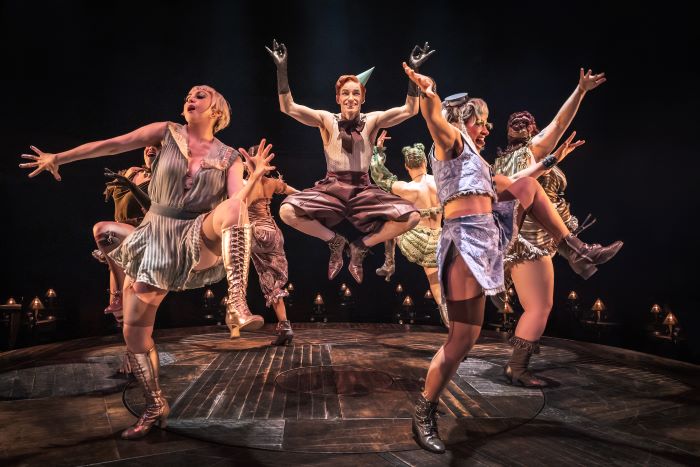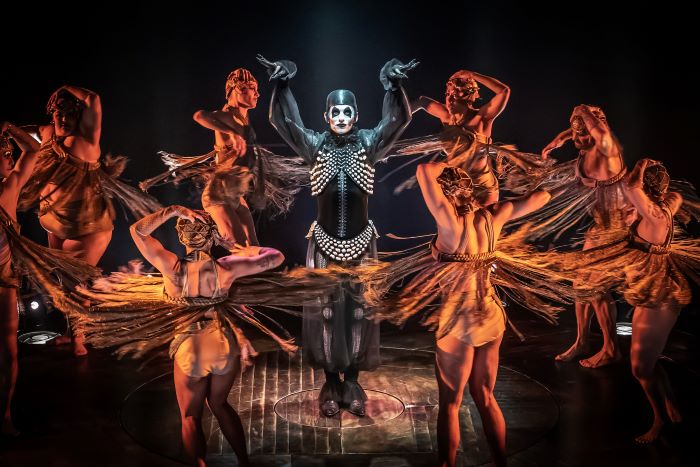When the original Broadway production of Cabaret, with music by John Kander, lyrics by Fred Ebb, and a book by Joe Masteroff (based on John Van Druten’s 1951 play I Am A Camera, inspired by Christopher Isherwood’s 1939 novel Goodbye to Berlin and 1945 collection of The Berlin Stories) made its debut in 1966, it ran for three years, played 1,166 performances, garnered eight Tony Awards, won a 1967 Grammy for its original cast album, and has remained one of the most popular and acclaimed musicals in history. It was soon adapted into the 1972 eight-time Oscar-winning film starring Liza Minnelli and directed by Bob Fosse, and has since been seen in six productions on London’s West End and four revivals on Broadway. The latest of those is Cabaret at the Kit Kat Club, which premiered in London in 2021, won seven Olivier Awards, is still running at The Playhouse Theatre there, and is now playing an open-ended engagement at Broadway’s August Wilson Theatre, with director Rebecca Frecknall, star Eddie Redmayne, and an artistic design team from the London hit.

Frecknall’s new immersive vision of the show includes a 75-minute prologue before curtain time, inviting us down an alleyway to the venue’s cellar, which has been converted into a secret underground speakeasy, with shots of liquor, bars with specialty cocktails, five suggestively clad Expressionist dancers (Alaïa, Iron Bryan, Will Ervin Jr., Sun Kim, and Deja McNair) and four musicians (Brian Russell Carey on piano and bass, Francesca Dawis on violin, Maeve Stier on accordion, and Michael Winograd on clarinet) roving through the crowd while performing to London-based composer Angus MacRae’s exoticizing music.
There’s also been an in-the-round transformation of the theater space, with VIP cabaret tables placed around a central bare rotating stage and its multi-level rising platforms, fringed lampshades with Edison bulbs that descend from above, spotlights in the darkness, shelves in front of each row of seats to hold the audience’s drinks, and the cast entering and exiting through the aisles and bringing select theatregoers up onto the stage with them. It’s all designed (club, set, and costumes by Tom Scutt; lighting by Isabella Byrd) to recreate the dissolute atmosphere of Cabaret’s iconic Kit Kat Club, to entice us to step inside their world, and to plunge us into the dark and decadent mood of the story, in which, at the performance I attended, everyone was more than happy to indulge.

Set in Berlin circa 1930, the historically based narrative portrays the seedy nightclub, its hedonistic denizens, and unfettered Emcee at a time that saw the rise of Nazism in the Weimar Republic, as experienced by American author Cliff Bradshaw. Renting a room at a boarding house owned by Fräulein Schneider, where he intends to write his new novel, he goes to the nearby Kit Kat Club and encounters its pleasure-seeking English singer Sally Bowles, who convinces him to take her in as a roommate, and they become non-exclusive lovers. But he is increasingly aware of the fascist threat to their sybaritic haven, pansexual lifestyle, and to the German Jews, including his landlady’s late-in-life love, the fruit vendor Herr Schultz, and is determined to leave the country, while the others naïvely minimize the situation, fearfully concede to the growing anti-Semitism, or join the Nazis.
Reprising his London role, Eddie Redmayne stars as the Emcee, whose costumes, postures, and demeanor are more reminiscent of a scary villainous clown from a 1990 Stephen King horror film than an alluring host welcoming everyone in every language to 1930 Berlin (in the famed “Wilkommen”), with his party hat, long black-gloved curling fingers and hand gestures, strange staccato movements, and dark sinister attitude (with an inconsistent German accent), and later in white face and an S&M skeletal suit. Gayle Rankin as Sally Bowles is aptly louche (in wigs and hair by Sam Cox), but instead of appearing sympathetically vulnerable, she’s pushy and crazed, loud and frequently off-key in her manic vocals (most notably in her frenetic performance of the title song, with wildly smeared make-up by Guy Common), and makes it hard to understand what the more observant Cliff, played with control and sensitivity by Ato Blankson-Wood, sees in her. The directorial choices made by Frecknall too often lose the humanity of the characters, in an effort to theatricalize the horrors of Nazism – unnecessarily, since the true historical reality and the impact it had on the people are more horrific than any overly dramatic vision could ever be.

In their featured roles, Henry Gottfried is convincingly slick and cunning as Ernst Ludwig, a well-dressed smuggler who befriends Cliff on the train to Berlin and eventually reveals his shocking affiliation, and Natascia Diaz brings vitality and humor to her dual roles of the prostitute Kost and Fritzie, one of the tawdry Cabaret Girls and Boys (along with Gabi Campo, Ayla Ciccone-Burton, Colin Cunliffe, Marty Lauter, Loren Lester, David Merino, Julian Ramos, MiMi Scardulla, and Paige Smallwood), performing Julia Cheng’s lurid choreography (“Two Ladies” is especially explicit in its use of a whisk, plunger, and more as phallic objects). And as Fräulein Schneider and Herr Schultz, Bebe Neuwirth and Steven Skybell bring believable emotion and empathy to the aging couple, whose pending marriage and future happiness together are destroyed by the changing political tide (and hair-raising sound by Nick Lidster for Autograph), in show-stealing portrayals that realistically capture the human essence of the tragedy.

The orchestrations of such legendary numbers as “Wilkommen,” “Two Ladies,” and “Cabaret,” “Don’t Tell Mama,” “Mein Herr,” “Maybe This Time,” and “Money,” played by a masterful nine-piece orchestra (with music direction by Jennifer Whyte), reaffirm the musical’s position as one of Broadway’s all-time greatest. And a sobering conclusion, with everyone dressed alike in drab monochrome suits, rotating on the stage, and listening silently to the Nazi anthem “Tomorrow Belongs to Me,” offers a stark contrast to the previous exuberant energy and debauchery of the Club, where its carefree regulars could relax, loosen up, and be themselves.
Despite some of the more over-the-top and anachronistic elements that didn’t work for me, Cabaret at the Kit Kat Club is a highly engaging and entertaining revival of a classic that should not only be seen, but fully experienced, so be sure to get there early for the prologue.
Running Time: Approximately two hours and 45 minutes, including an intermission, plus an optional prologue that begins 75 minutes before curtain time.
Cabaret at the Kit Kat Club plays an open-ended run at the August Wilson Theatre, 245 West 52nd Street, NYC. For tickets (priced at $109-599, plus fees, and optional dining and drinks packages priced at $80-105), go online.
Before you go, you can watch the trailer here:






I can only imagine the atmosphere created by Angus MacRae’s exotic music. Thanks for sharing this exciting glimpse into the production!